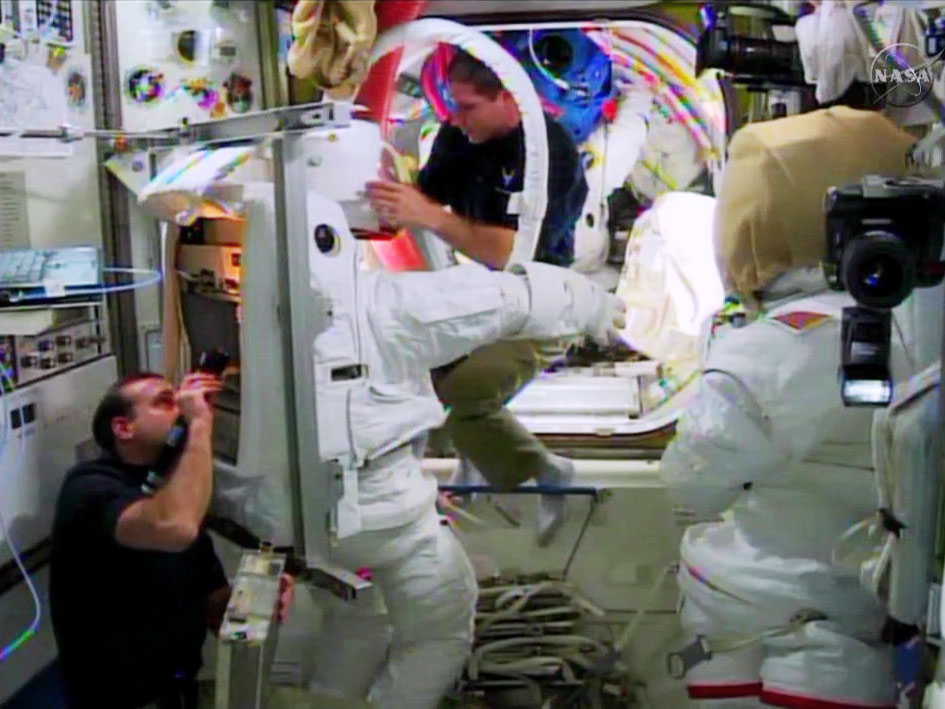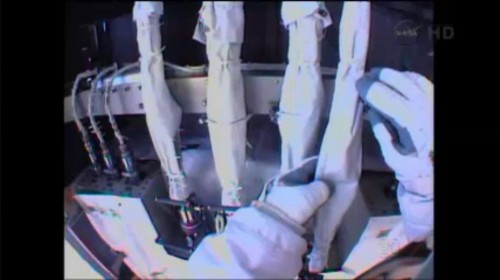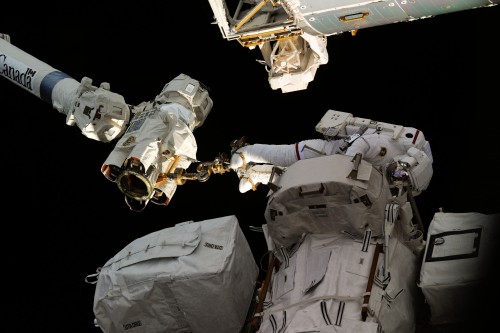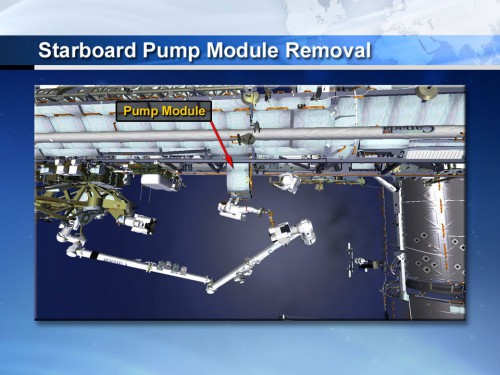
Expedition 38 astronauts Rick Mastracchio and Mike “Hopper” Hopkins will wait until Christmas Eve before making their second spacewalk, following “a space suit configuration issue” in the aftermath of yesterday’s highly successful EVA-24 to remove a failed 780-pound (350-kg) ammonia pump module from the International Space Station’s S-1 truss. Working as much as 90 minutes ahead of the timeline for most of the excursion, the astronauts were asked by Mission Control for their consensus on extending EVA-24 from 6.5 hours to as long as 7.5 hours, which Mastracchio initially seemed to support. However, it was considered more prudent to wrap up their tasks with the securing of the failed pump module and wait for EVA-25 to move and install a replacement.
NASA confirmed last night that it will postpone EVA-25—originally scheduled for Monday, 23 December—by 24 hours, until Christmas Eve, which almost certainly means that a historic spacewalk on the traditional date of Christ’s birth is unlikely. “The extra day will allow time for the crew to resize a spare space suit on the space station for use by Mastracchio,” the agency reported in a news release. “During repressurization of the station’s airlock, following the spacewalk, a space suit configuration issue put the suit Mastracchio was wearing in question for the next excursion.” Specifically, NASA pointed to the question of whether water entered the suit’s sublimator whilst inside the Quest airlock. The agency stressed that this issue was “not related” to the unfortunate incident of water intrusion into Luca Parmitano’s helmet, which curtailed EVA-23 in July, and that both Mastracchio and Hopkins remained dry throughout their five hours and 28 minutes outside.
Yesterday’s EVA to begin the process of removing and replacing the failed S-1 pump module proceeded with spectacular smoothness, and the spacewalkers appear to have encountered only minor problems. As noted in an earlier AmericaSpace article, the need for EVAs became acute following the automatic shutdown of the starboard pump module on one of the station’s external ammonia coolant loops back on 11 December. The shutdown was effected when pre-set temperature limits were reached.

NASA flight controllers worked to get the loop back up and running, and suspicion quickly centered on the improper functionality of a regulating flow control valve inside the pump module. By regulating the temperature of ammonia in the coolant loop, the valve ensures that when it is re-introduced into the heat exchanger of the station’s Harmony module, it does not freeze the water also passing through the exchanger. Although NASA stressed that the six-man Expedition 38 crew—consisting of Mastracchio and Hopkins, together with Japan’s Koichi Wakata and Russian cosmonauts Oleg Kotov, Sergei Ryazansky, and Mikhail Tyurin—was in no danger, engineers worked to move certain critical systems over to the second coolant loop, and a number of non-critical elements were powered down inside Harmony, together with Japan’s Kibo and Europe’s Columbus laboratory modules.
Replacing the valve itself was never an option, since its location within the pump module is inaccessible to the hands of spacewalkers. Only the removal and replacement of the entire pump module—of which three “spares” were delivered to the ISS by the shuttle—was a realistic possibility. Three years ago, in August 2010, the S-1 pump module failed and was replaced during three tricky EVAs by Doug Wheelock and Tracy Caldwell-Dyson. Both astronauts supported preparations for EVA-24 by completing a training run in the Partial Gravity Simulator (POGO) test area of the Johnson Space Center’s Space Vehicle Mockup Facility, and Wheelock served as lead Capcom for yesterday’s spacewalk.
Back in 2010, the spacewalkers experienced difficulties removing the four ammonia fluid quick disconnects (QDs) from the failed pump module, which Caldwell-Dyson told NASA Public Affairs Officer Josh Byerly was partly attributable to the fact that they were at 300 psi of pressure. Since then, lessons have been learned, she said, and the pressure in the lines has been lowered to around 180 psi. This appeared to have aided Mastracchio and Hopkins immeasurably, for the men stepped smartly through the demating of the QDs and their valves were promptly confirmed closed by the Station Power, Articulation and Thermal Control (SPARTAN) console in Mission Control.

Late in the EVA, as the spacewalkers worked about 90 minutes ahead of the timeline, they were asked for their consensus on an extension from 6.5 hours to as long as 7.5 hours, which seemed favorable to them. Hopkins returned to Quest to recharge his oxygen supply, and Mission Control requested them to prepare to move over to External Stowage Platform (ESP)-3—where the replacement pump module is situated—to begin the process of removing its securing bolts and fasteners, ahead of movement. At this stage, Mastracchio seemed keen to break torque on the bolts, but was advised that the tasks at ESP-3 would entail additional work. As a consequence, Mastracchio expressed his preference to end the EVA and defer the ESP-3 work until EVA-25, a position which Mission Control later accepted. Whether Mastracchio was in a measure of discomfort or pain—he had expressed minor concerns about coldness in his suit earlier in the spacewalk—is unknown, despite speculation in some areas of the media.
On Earth, the huge success of what had been expected to be an intricate and tricky EVA was rightly lauded by many present and former astronauts on Twitter. Chris Ferguson, who commanded the final shuttle mission, STS-135, in July 2011, praised a “Nice job by Rick and Hopper” and added “Wish we could bring this broken [pump module] home too,” whilst France’s Thomas Pesquet declared that Mastracchio and Hopkins had “just aced their spacewalk” … as he had just aced his Christmas shopping! Pesquet concluded that both counted as a marathon, but that “I’d give a lot to switch!” Former astronaut Clay Anderson—Mastracchio’s EVA partner from STS-118 and STS-130—endorsed his crewmate’s decision, writing: “No need to stretch the spacewalk further when you have two of the best ready for EVA-2. All will be well.” Meanwhile, veteran spacewalker and former ISS resident Ron Garan expressed a hope that “U guys should seriously consider taking rest of the day off.”

Looking ahead to Tuesday’s planned EVA-25, attention is drawn to the plans for a three-spacewalk repair effort, as highlighted last week by Lead U.S. Spacewalk Officer Allison Bolinger. All of the EVA-24 tasks, which entailed the removal of ammonia fluid QDs and electrical connectors and fasteners from the failed pump and the release of multi-layer insulation from the replacement pump, were successfully completed. Key EVA-25 tasks were also completed, including the physical removal of the failed pump module from the S-1 truss and its attachment to a temporary-stowage location on the Payload Orbital Replacement Unit (ORU) Accommodation (POA) on the station’s Mobile Base System (MBS).
The next step, to kick of Christmas Eve’s spacewalk, will see Mastracchio and Hopkins translate over to the ESP-3 worksite, where the replacement pump module is situated. This pump module was delivered to the space station by the STS-127 shuttle crew back in July 2009. With Mastracchio riding Canadarm2, and Hopkins free-floating, robot arm operator Koichi Wakata will fly the new pump module over to the S-1 truss worksite and the spacewalkers will install it. Original plans called for EVA-25 to end with the mating of fasteners and electrical connectors, but it seems more likely that the spacewalk will now include many of the EVA-26 tasks: to establish the connections of the ammonia fluid QDs to the new pump module and move the failed unit over from the POA to its final location on ESP-3. Although it remains unclear as to whether the second half of the originally planned EVA-25 and the entirety of EVA-26 can be completed in a single spacewalk on Tuesday, the pace at which Mastracchio and Hopkins worked yesterday carries great promise.
With the completion of their first spacewalk, Hopkins has now entered the record books as the 206th person in history to venture outside a spacecraft in a pressurized suit, since Alexei Leonov’s pioneering “swim” in space in March 1965. It was also the 175th EVA dedicated to construction and maintenance of the International Space Station. As for Mastracchio, he has now concluded his seventh career EVA … and has jumped 12 places in the list of most experienced spacewalkers of all time. Yesterday morning he came in at No. 27, with 38 hours and 30 minutes of cumulative EVA time, but now his additional five hours and 28 minutes from EVA-24 have pushed him into 15th place. He now sits just 28 minutes ahead of fellow pump module veteran Doug Wheelock and 27 minutes behind the 14th place-holder, Russian cosmonaut Nikolai Budarin. A 6.5-hour spacewalk on Christmas Eve should see Mastracchio’s place move further to No. 7 on the list.
Want to keep up-to-date with all things space? Be sure to “Like” AmericaSpace on Facebook and follow us on Twitter: @AmericaSpace




Superb space walk. I should imagine they’re tired today.
They deserve their Christmas holiday break today!
Seasons greeting one and all.